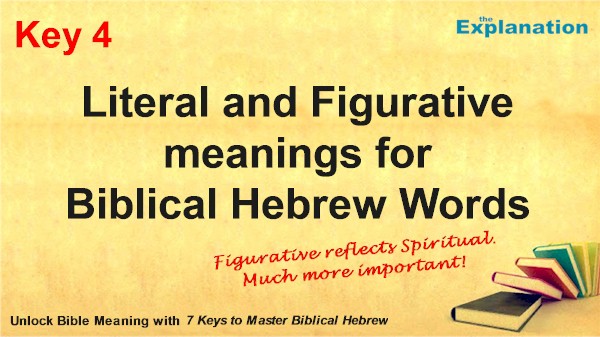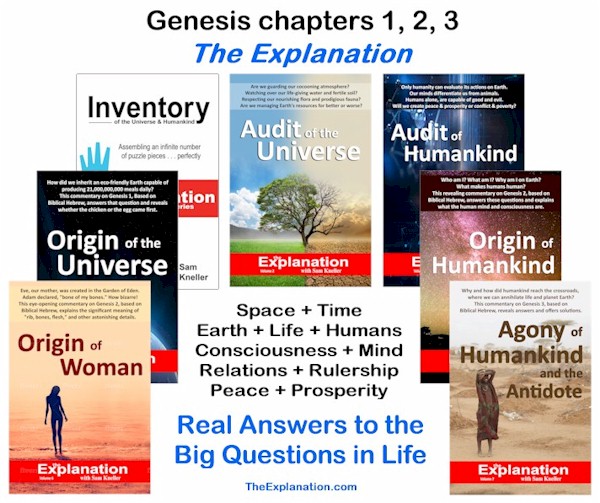Contents
Literal and figurative meanings is probably the most under-used key to a deeper comprehension of Biblical Hebrew.

Key 4. Literal and Figurative meanings for Biblical Hebrew words. Figurative reflects the spiritual, much more important.
Literal and figurative vocabulary meanings are not unique to Hebrew; we find it in English and other languages too. For example, night literally is the twelve-hour period of darkness, but figuratively we use it in expressions like a long night for the survivors. This can be figurative, referring to dark, evil, and confusion.
(Bible Course, Unlock Bible Meaning with the 7 Keys to Master Biblical Hebrew, Key 4)
Translations only render one of those meanings, generally the most obvious, the literal meaning. Whereas the figurative or spiritual event is the MOST important. We must learn that literal and figurative go hand-in-hand. I’d even say, when we see something literally strange, we should search out the deeper literal and figurative meaning. Here’s a video about literal and figurative in English.
Darkness and Deep
Case in point: Genesis 1:2 where we read, “darkness was upon the face of the deep.” For the Biblical Hebrew words: Darkness and deep in Genesis. The 4th Key, literal and figurative meanings of Biblical Hebrew words, swings in action.
If you read such words as darkness, deep, light, even words like beginning, create, heaven, in the context of darkness before creation in Genesis 1:1-2, ONLY keeping in mind your native language meanings, you are missing the essential understanding. We have a LITERAL knowledge of the meaning of the words darkness and deep, so we don’t give it much more attention than that.
A basic understanding of the usage of Biblical Hebrew, here, the 4th key, the literal and figurative meaning of words, is essential as we will see. Other contexts clearly reveal their FIGURATIVE meanings. This is not interpretation. This is corroboration.
What The Explanation calls Bible-wide corroboration. This is a term I use frequently. Why? Because we are putting a puzzle together and all the pieces assemble perfectly. We can find related pieces of the puzzle. They could be literal and figurative, in different chapters and books, even in different Testaments (Old and New). But, and this is vital, ALL the pieces corroborate each other. That’s what we mean by Bible-wide.
If all you grasp from Genesis 1:2 is the LITERAL darkness, you’ve missed at least half the meaning which the translations cannot transmit. It’s probable that the FIGURATIVE comprehension will be more important than the literal translation. What is the implication of this? What does it do for comprehension when we miss over fifty percent of the author’s meaning? Right from the start, in the first five minutes of the Genesis narrative, God uses the literal and figurative key.
Here’s the first part of Genesis 1:2, “And the earth was without form, and void; and darkness was upon the face of the deep…” Immediately following this description of the decrepit state of the Earth we see the words darkness and deep. They correspond to Strong’s H2822 and H8415. Instead of giving them a quick glance, let’s unlock Bible meaning.
Darkness
Here is Strong’s reference to darkness, followed by 2 verses in the Old and one verse in the New Testament to confirm the use of the literal and figurative 4th key.
חֹשֶׁךְ chôshek kho-shek’; from H2821 (חָשַׁךְ); the dark; hence (literally) darkness; figuratively, misery, destruction, death, ignorance, sorrow, wickedness:
KJV – dark(-ness), night, obscurity.
Who leave the paths of uprightness, to walk in the ways of darkness; (Sam, sin or unrighteousness)
Ecclesiastes 6:4
For he comes in with vanity, and departs in darkness, and his name shall be covered with darkness. (Sam, the vain person departs in ignorance covered in shame)
Ephesians 5:8
For you were sometimes darkness, but G1161 now are you light in the Lord: walk as children of light: (Sam, the contrast of coming out of wrong-doing to walk in right-doing).
Do you see the figurative meaning of darkness?
Deep
Deep (H8415), as you now can easily understand, also carries a meaning beyond literal depth.
תְּהוֹם tᵉhôwm teh-home’; or תְּהֹם; (usually feminine) from H1949 (הוּם); an abyss (as a surging mass of water), especially the deep (the main sea or the subterranean watersupply):
KJV – deep (place), depth.
H1949 הוּם hûwm hoom; a primitive root (compare H2000 (הָמַם)); to make an uproar, or agitate greatly:
KJV – destroy, move, make a noise, put, ring again.
H2000
הָמַם hâmam haw-mam’; a primitive root (compare H1949 (הוּם), H1993 (הָמָה)); properly, to put in commotion; by implication, to disturb, drive, destroy:
KJV – break, consume, crush, destroy, discomfit, trouble, vex.
There is much to learn from this darkness that corroborates the tohu and bohu. This chaotic scene was present BEFORE creation week. In the lesson on Key 3, we saw that beginning (beraisheet) also had the meaning excellent. So, this excellent beginning somehow got into a state of chaotic destruction and the 7 day creation week was to REcreate a beautiful, appropriate environment for humankind. Those are the Bible puzzle pieces. For more information, please refer to Origin of the Universe.
Back to Strong’s. Check it for yourself. At creation week, not only was there absence of light but darkness figuratively means to destroy, and make a noise. Look at Psalms 55:2, “Attend to me, and hear me: I mourn in my complaint, and make a noise (H1949).” The literal and figurative meaning of darkness is the noise or moaning and groaning of someone with a complaint, someone in pain. That’s the result of the tohu va bohu.
Please notice that all Strong and Kneller are doing is showing you how these same words (darkness, deep, light, beginning, created…) are being used in other instances in the Bible. The literal and figurative meanings. Nobody is interpreting anything.
Let’s go a step further into deep water (figurative speech) with this reasoning. If you’ve been reading The Explanation, even for a little while, you know I don’t pull any punches (figurative speech), Let’s bridge the gap (figurative speech) between those who comprehend the way the Author composed the Bible and those who laugh at how ridiculous such Bible conjecture is.
Literal preFIGURES Literal
For the sake of clarity, here’s a story everyone has heard. Possibly one of the best-known stories of the Old Testament, Noah’s ark. Featured in comics to movies, faith, and scorn. A worldwide flood that covered the top of the highest mountain (see verses 19-20 below). Literally, everything physical, including peaks, trees, animals, birds, insects, all material entities contained on planet Earth were completely and wholly covered with water. I’ve used hyperbole, over-exaggerated adjectives, to drive this point home (figurative speech).
If we want to get picky, how could anyone know that the water covered every mountain worldwide? After all, all survivors were in the closed ark, they couldn’t see and they didn’t travel to every place around the world! People ridicule this, even people who accept this on faith, don’t understand WHY God had to cover the mountains. Here’s the context.
18 And the waters prevailed, and were increased greatly upon the earth; and the ark went upon the face of the waters.
19 And the waters prevailed exceedingly upon the earth; and all the high hills, that were under the whole heaven, were covered.
20 Fifteen cubits upward did the waters prevail; and the mountains were covered.
21 And all flesh died that moved upon the earth, both of fowl, and of cattle, and of beast, and of every creeping thing that creepeth upon the earth, and every man:
22 All in whose nostrils was the breath of life, of all that was in the dry land, died.
23 And every living substance was destroyed which was upon the face of the ground, both man, and cattle, and the creeping things, and the fowl of the heaven; and they were destroyed from the earth: and Noah only remained alive, and they that were with him in the ark.
Non-believers and antagonists have a heyday with this narrative. Where could you ever get enough water to accomplish such a literal task? Cover Mount Everest at almost 9000 meters, with water, how ridiculous! As a parenthesis, those same savant people would tell us that meteorites deposited the torrents of water on Earth, but that’s another story.
Did the flood cover the highest mountain? Was it worldwide? Yes, yes. How can I affirm that? Because the literal flood figuratively represents events of monumental importance.
If you balk at the literal explanation, you will not even consider the figurative explanation.
God is hiding His truth in broad daylight. “At that time Jesus answered and said, I thank you, O Father, Lord of heaven and earth, because you have hid these things from the wise and prudent, and have revealed them to babes (Matthew 11:25).” God uses the literal and figurative key to hide the meaning from non-believers. Some believers only accept a “local flood,” and scorn the full narrative.
For a start, the flood confirms the 2 Trees in the Garden of Eden. Or death or life, there’s no in-between. “The world that then was,” represents death (2 Peter 3:6), and the ark represents life. But beyond that, Noah’s flood preFIGURED the future destruction, death, of the entire physical Earth by fire, and those saved for eternal life, transformed into spirit beings (1 Corinthians 15:50-54). This will take place when God fulfills His plan for humankind.
5 For this they willingly are ignorant of, that by the word of God the heavens were of old, and the earth standing out of the water and in the water:
6 Whereby the world that then was, being overflowed with water, perished:
7 But the heavens and the earth, which are now, by the same word are kept in store, reserved unto fire against the day of judgment and perdition of ungodly men.
Literal and figurative. Literal water and fire are figurative of BOTH destruction and salvation. They both destroy the wicked and save the righteous. The water bore the ark up and saved it. The fire has no effect on spirit beings. At the end of God’s plan for humanity, this fire is literal. So, the literal water prefigures the literal fire.
Bible Study Exercise
- Go to UnlockBibleMeaning.com
- find Genesis 7:18 and the word ark
- Switch to Strong’s concordance and click on H8382 (ark)
- Then, at the bottom of H8392 click on Hebrew Concordance for H8392
- You’ll see all the verses in the KJV where you find H8392 – ark
- There’s only one other context. Moses and the ark his mother made to SAVE him.
The ark on the water is an instrument of salvation, just at it saved Noah.
Literal and figurative references to water are elsewhere in the Bible. Again, in examples that many people, even believers, question. For instance, the crossing of the Red Sea when Moses, or rather God, parted the waters. The literal water prefigures both baptism for the Israelites and the destruction of sin for the Egyptians.
1 Moreover, brethren, I would not that ye should be ignorant, how that all our fathers were under the cloud, and all passed through the sea;
2 And were all baptized unto Moses in the cloud and in the sea;
3 And did all eat the same spiritual meat;
4 And did all drink the same spiritual drink: for they drank of that spiritual Rock that followed them: and that Rock was Christ.
As you can read in the above passage, there are several literal and figurative references. The cloud that covered the Israelites, the sea through which they passed, the manna that provided all the sustenance for their health and the Rock which provided the water they needed. These preFIGURATIONS represent baptism, the Holy Spirit, God’s Word, and Christ. The essentials we need in the New Testament covenant, they possessed in the Old Testament covenant. There’s was physical, ours is spiritual. Again, the literal and figurative representation. Here’s another Bible-wide corroborative verse in this context of water, Noah’s flood, and baptism.
20 Which sometime were disobedient, when once the longsuffering of God waited in the days of Noah, while the ark was a preparing, wherein few, that is, eight souls were saved by water.
21 The like figure whereunto even baptism does also now save us (not the putting away of the filth of the flesh, but the answer of a good conscience toward God,) by the resurrection of Jesus Christ:
The above context encloses a lot of Christian teaching, which I cannot broach now. But did you note “the like FIGURE” in verse 21? Peter compares the ark to baptism specifically using to the 4th Key, literal and figurative meanings. He knew all the Keys but I doubt he had a course with 7 Keys that reader can register to study!
Let’s conclude this lesson with a final Biblical Hebrew word related to Noah’s flood that clearly reveals the literal and figurative 4th Key to unlock Bible meaning.
Make you an ark of gopher wood; rooms shall you make in the ark, and shall pitch (H3722) it within and without with pitch. (H3724)
Here’s the Hebrew for both the verb (H3722) and the noun (H3724) pitch.
כָּפַר kâphar kaw-far’; a primitive root; to cover (specifically with bitumen); figuratively, to expiate or condone, to placate or cancel:
KJV – appease, make (an atonement, cleanse, disannul, forgive, be merciful, pacify, pardon, purge (away), put off, (make) reconcile(-liation).
H3724
כֹּפֶר kôpher ko’-fer; from H3722 (כָּפַר); properly, a cover, i.e. (literally) a village (as covered in); (specifically) bitumen (as used for coating), and the henna plant (as used for dyeing); figuratively, a redemption-price:
KJV – bribe, camphire, pitch, ransom, satisfaction, sum of money, village.
Read the KJV translation and meditate the literal and figurative different meanings of this one Biblical Hebrew word, pitch.
Authorship of God’s Word
Once you understand this forth key, please meditate on another aspect of authorship of the Bible. Making the literal and figurative correlate. What I mean by that is the only reason that both Noah’s and Moses’ arks SAVE is because they’re coated with pitch. The only reason God can save us is because 1. God PARDONS (H3722) our sins the figurative portrayed by the literal pitch and 2. We CLEANSED (H3722) and RECONCILED (H3722) by an ATONEMENT (H3722), again the figurative portrayed by the literal pitch.
The Biblical Hebrew language incorporates LITERAL pitch with Figurative (but spiritually real) pardon, cleansing, reconciling, and atonement. There’s NO WAY to see this in any translation. A genius mind, God’s mind alone, can establish this use of language with related literal and figurative meaning.
Think. There are hundreds, even thousands of literal and figurative expressions in God’s Word. He incorporates them across verses, chapters, books, and Testaments. Different Biblical writers over hundreds of years, who obviously didn’t know each authored these literal and figurative examples. The literal and figurative meanings of words incorporate examples in both Hebrew and Greek and probably Aramaic.
This is amazing, no, it’s unbelievable. This is not some crazy hidden code where you have to count and calculate or interpret. This is a key to comprehension, literal and figurative, that unlocks Bible meaning. It is a miracle of authorship that NO human being could even begin to incorporate in a text. This is evidence that should increase your faith in the validity of Scripture and the Power of God. This is the underlying basis of canonization, the authorship and transmission of the Holy Word of God.
Value of Strong’s Concordance
We use Strong’s precisely because he recognizes literal and figurative relationships. I hope you noticed H3724, just above, Strong uses the exact terminology, literally and figuratively. In H3722 he notes figurative but not literal. However, he mentions bitumen, which is very literal.
Maybe you’ve never noticed these inclusions before. I daresay most of Strong’s detractors don’t stop to contemplate his erudition. They should, and I hope you will. No, he does not mention it every time, and no, he and his concordance are not perfect, which is fine. After all, there’s so much to consider, and he was not writing a commentary. Let’s give credit where credit is due.
As you use Strong’s you will see this Key, literal and figurative, more and more, in hundreds of entries. It’s one of the most fascinating keys to unlock Bible meaning.
This blog post is an excerpt from Key 4 of the Bible Course Unlock Bible Meaning with the 7 Keys to Master Biblical Hebrew.
Dig Deeper into The Explanation
Online Study Courses to Uncover the Mystery of Adam and Eve’s Nakedness… with no fuss. Free video mini-course revealing the God-intended meaning of Scripture via Biblical Hebrew. It’s so easy, it’ll blow you away. Join now and add new motivation to your Bible study.
Join The Explanation Newsletter to stay informed of updates. and future events. No obligations, total privacy, unsubscribe anytime, if you want.
The Explanation series of seven books. Free to read online or purchase these valuable commentaries on Genesis 1-3 from your favorite book outlet. E-book and paperback formats are available. Use this link to see the details of each book and buy from your favorite store.

Since you read all the way to here… you liked it. Please use the Social Network links just below to share this information from The Explanation, Key 4. Literal and Figurative Meanings for Biblical Hebrew Words



Trackbacks/Pingbacks